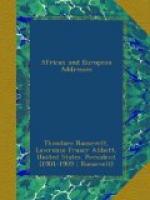Then, for no reason that we can assign, destruction fell on this fauna. All the great and terrible creatures died out, the same fate befalling the changed representatives of the old autochthonous fauna and the descendants of the migrants that had come down from the north. Ground sloth and glyptodon, sabre-tooth, horse and mastodon, and all the associated animals of large size, vanished, and South America, though still retaining its connection with North America, once again became a land with a mammalian life small and weak compared to that of North America and the Old World. Its fauna is now marked, for instance, by the presence of medium-sized deer and cats, fox-like wolves, and small camel-like creatures, as well as by the presence of small armadillos, sloths, and ant-eaters. In other words, it includes diminutive representatives of the giants of the preceding era, both of the giants among the older forms of mammalia, and of the giants among the new and intrusive kinds. The change was widespread and extraordinary, and with our present means of information it is wholly inexplicable. There was no ice age, and it is hard to imagine any cause which would account for the extinction of so many species of huge or moderate size, while smaller representatives, and here and there medium-sized representatives, of many of them were left.
Now as to all of these phenomena in the evolution of species, there are, if not homologies, at least certain analogies, in the history of human societies, in the history of the rise to prominence, of the development and change, of the temporary dominance, and death or transformation, of the groups of varying kind which form races or nations. Here, as in biology, it is necessary to keep in mind that we use each of the words “birth” and “death,” “youth” and “age,” often very loosely, and sometimes as denoting either one of two totally different conceptions. Of course, in




